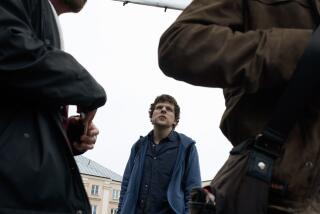BOOK REVIEW : The Holocaust’s Awful Truth, as Told by Its Survivors : SCHINDLER’S LEGACY: True Stories of the List Survivors, <i> by Elinor J. Brecher</i> (Dutton; 27.50, 442 pages. Paperback: Plume, $14.95)
Among the 6 million children, women and men who were murdered by the Nazis and their accomplices, only one--Anne Frank--is widely remembered by name.
*
Even among the survivors, only a precious few are readily known: Elie Wiesel, Simon Wiesenthal, Primo Levi.
And, ironically, today’s most celebrated Holocaust survivors are known only by the name of the Nazi war profiteer who deigned to spare them from death at Auschwitz. They are the fortunate ones whose names appeared on “Schindler’s List.”
Now Elinor J. Brecher gives names, faces and voices to many of the so-called Schindlerjuden (“Schindler Jews”) in “Schindler’s Legacy.” Members of 31 families (out of 400 or so survivors still alive) step out of the shadows of history--and the crowd scenes of Steven Spielberg’s movie--to share what they experienced and how they survived.
“If I am--God forbid--a nobody,” says survivor Murray Pantirer, “then 6 million nobodies were killed by the Germans.”
Thomas Keneally, who wrote the memorable and important book on which Spielberg’s movie is based, contributes a foreword to “Schindler’s Legacy,” in which he readily concedes that Oskar Schindler--and not the survivors--was the crucial figure in both works. He salutes Brecher for searching out the Schindlerjuden to give their own “vigorous testimonies.”
“Here,” Keneally writes, “we have the memories of the Schindler survivors in their own right.” Brecher forgives Spielberg for “a certain amount of cinematic license,” but “Schindler’s Legacy” allows the survivors to fill in the details. Often, they point out the liberties that Spielberg took with the truth; almost invariably, the truth is far more horrific.
“(Spielberg’s) dogs wore muzzles; audiences didn’t see them gnawing men’s genitals and women’s breasts like so much hamburger,” writes Brecher about the difference between Spielberg’s version of the Holocaust and the memories of the survivors. “Spielberg’s storm troopers refrained from swinging infants by their feet into brick walls, smashing their skulls like melons.”
Some of the memories are blood-chilling, some heartbreaking, some darkly celebratory. Henry Rosner, forced to play the violin while his captors caroused, describes how he fiddled one morose Nazi officer to death by playing a tune called “Gloomy Sunday” over and over until the drunken German pulled out a pistol and shot himself. Later, a fellow survivor asked to kiss “the hand that killed a Nazi.”
But memories of the Holocaust are not the only or even the most important element of Brecher’s book. “Schindler’s Legacy” describes the lives--and not merely the sufferings--of the survivors. We hear their tales of childhood, we share their fears and dreams, we come to know their loved ones; that’s why the moments of torture and murder become all the more atrocious. And Brecher shows us, too, the ordeal of a life haunted by death--the tortured stay tortured.
“To enjoy life to some extent and not be constantly depressed, you can’t keep on celebrating horrors,” says Helen Sternlicht Rozenzweig, who served as a housemaid to camp commandant Amon Goeth. “In my dreams, I keep going by train back to Poland.”
A survivor’s family photograph, showing two young sisters dressed in outlandish clown costumes, sent shivers down my spine and put a lump in my throat; the girls are years away from the day when the Nazis would kill one and Schindler would spare the other. This, I realized, is what the victims of the Holocaust really look like: ordinary but endearing, innocent but doomed.
“When one saves a life,” goes a Talmudic saying made famous by “Schindler’s List,” “it is as if he saved the whole world.” Brecher has accomplished something very much the same in “Schindler’s Legacy.” By giving names and faces to a few otherwise anonymous survivors, it is as if she rescued 6 million dead souls from the terrible obscurity of the crematories and the unmarked graves.
More to Read
Sign up for our Book Club newsletter
Get the latest news, events and more from the Los Angeles Times Book Club, and help us get L.A. reading and talking.
You may occasionally receive promotional content from the Los Angeles Times.






